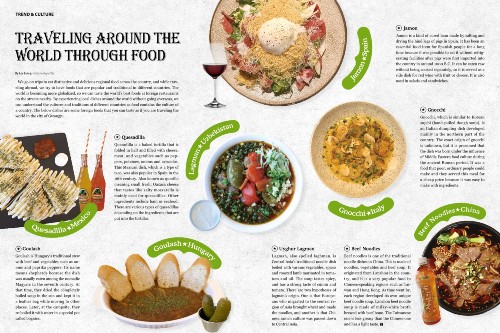
We go on trips to eat distinctive and delicious regional food across the country, and while traveling abroad, we try to have foods that are popular and traditional in different countries. The world is becoming more globalized, so we can taste the world’s best foods at foreign restaurants on the streets nearby. By experiencing local dishes around the world without going overseas, we can understand the cultures and traditions of different countries as food contains the culture of a country. Especially now under the COVID-19 pandemic, traveling abroad is difficult, but you can have a chance to experience the unique atmosphere of a foreign country through exploring food. Over the years, the number of international students studying at Chonnam National University and also the number of foreign residents have increased, and eventually, it has become easy to taste various international foods near our campus and in Gwangju. The below dishes are some foreign foods that you can taste as if you are traveling the world in the city of Gwangju.
Goulash, Hungary
Goulash is Hungary’s traditional stew with beef and vegetables such as onions and paprika peppers. Its name means shepherds because the dish was usually eaten among the nomadic Magyars in the seventh century. At that time, they dried the completely boiled soup in the sun and kept it in a leather bag while moving to other places. Later, at the campsite, they re-boiled it with water in a special pot called bogrács.
Quesadilla, Mexico
Quesadilla is a baked tortilla that is folded in half and filled with cheese, meat, and vegetables such as peppers, potatoes, onions and avocados. This Mexican dish, which is a type of taco, was also popular in Spain in the 16th century. Also known as quesillo meaning small fresh, Oaxaca cheese that tastes like salty mozzarella is mainly used for quesadillas. Other ingredients include ham or seafood. There are various types of quesadillas depending on the ingredients that are put into the tortillas.
Jamon, Spain
Jamon is a kind of cured ham made by salting and drying the hind legs of pigs in Spain. It has been an essential food item for Spanish people for a long time because it was possible to eat it without refrigerating facilities after pigs were first imported into the country in around 1000 B.C. It can be eaten raw without being cooked separately, so it is served as a side dish for red wine with fruit or cheese. It is also used in salads and sandwiches. Each region in the country has its own different types of jamon, depending on the type of pig and the aging process.
Gnocchi, Italy
Gnocchi, which is similar to Korean sujebi (hand-pulled dough soup), is an Italian dumpling dish developed mainly in the northern part of the country. The exact origin of gnocchi is unknown, but it is presumed that the dish was born under the influence of Middle Eastern food culture during the ancient Roman period. The Romans made gnocchi by mixing eggs with dough made of flour. It was a food that poor, ordinary people could make and they served this meal for a cheap price because it was easy to make with ingredients, such as potatoes, flour, and water, commonly available to them.
Lagman, Uzbekistan
Lagman, also spelled laghman, is Central Asia’s traditional noodle dish boiled with various vegetables, spices and roasted lamb marinated in tomatoes and oil. The soup tastes spicy, and has a strong taste of cumin and tomato. There are two hypotheses of lagman's origin. One is that Europeans who migrated to the central region of Asia brought wheat and made the noodles, and another is that Chinese ramen culture was passed down to Central Asia.
Beef Noodles, China
Beef noodles is one of the traditional noodle dishes in China. This is made of noodles, vegetables and beef soup boiled for a long time with beef, beef bones, and various spices. It originated from Lanzhou in the country, and it is a very popular food in Chinese-speaking regions such as Taiwan and Hong Kong. As time went by, each region developed its own unique beef noodle soup. Lanzhou beef noodle soup is made of milky-white broth brewed with beef bone. The Taiwanese one is less greasy than the Chinese one and has a light taste.
By Lee Eun-ji, Tribune Reporter

